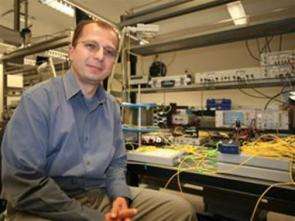Engineers Demonstrate Revolutionary Photonic Technology

Until now much of the investment on equipment to generate, transport and detect signals traveling through optical fiber has revolved around 1.55 micron (infrared) as the standard wavelength for telecommunications. Yet many critical new applications rely on other wavelengths (colors) for optical transmission that hitherto could not be generated, carried or received by today's standard equipment. Now, researchers at the University of California, San Diego have demonstrated a way to build on the dominant infrastructure rather than replace it -- by "translating" optical signals between the current infrared standard and a wide range of other bands of light.
At the Optical Fiber Conference in Anaheim, CA, earlier this month, the team from UCSD's Jacobs School of Engineering announced that they successfully used a parametric process in photonic crystal fiber to change the wavelengths of modulated optical channels from 1.55 micron (1550 nanometers) infrared to a visible light signal at half a micron -- a record 1 micron difference. The researchers measured a difference in frequency between the infrared starting point and the visible-light end point of 375 terahertz (THz), a factor of ten greater than previously achieved.
"This work demonstrates a revolutionary technology for new applications that include airborne and submarine communications, standoff spectroscopy and remote sensing," said Stojan Radic, a professor of Electrical and Computer Engineering (ECE) in the Jacobs School and leader of the UCSD team. "The parametric band translator means that mature telecom technology can be applied to any other wavelength, permitting development of new applications at various bands without requiring huge investment in new infrastructure to replace what already exists."
In the UCSD tests, information was encoded into 1.55 micron light, the standard because that is where the glass fiber is most transparent and efficient for transmission, offering tremendous bandwidth up to 12,000 gigahertz. Using a nonlinear optical process, the signal was recreated in a very different 0.5 micron green light and received by a standard visible-light detector. "Other researchers have shown the ability to create new colors of light via nonlinear processes and to move data signals between nearly identical wavelengths," said Radic. "In this case we showed that the wavelengths can be very different and still carry the same high-speed data signal. We completed data recovery with zero errors, even though the new color was very different from the starting color."
Researchers also reported the first multiple channel mapping over the same spectral range, thus demonstrating arbitrary capacity mapping across the entire visible band.
"This is an amazing accomplishment, and Professor Radic never ceases to amaze me with his ambition and vision of what is possible," said Larry Smarr, a professor of computer science and engineering in the Jacobs School and director of the California Institute for Telecommunications and Information Technology (Calit2), which is supporting Radic's work through the institute's new Photonics Lab at UCSD. "This experiment is precisely the type of cutting-edge research that we expect will be a hallmark of the projects enabled as more and more faculty move into the new lab."
Radic and three other ECE professors—Shaya Fainman, Joseph Ford and George Papen—are participating in four core projects in high-capacity and unconventional networking research in the Calit2 lab. In addition to the universal band translator, they are developing an innovation in transmission architecture that holds the promise of dramatically reducing the cost of existing high-capacity networks. Another core project involves ultrawideband division multiplexing to boost one-hundredfold the transmission capacity through a single fiber, while a fourth project underway in the Photonics Lab is focused on “ultrafast and coherent” signal processing.
The ability to translate signals for transport through the fiber transmission window has dramatic implications for equipment manufacturers and users. Telecom and fiber-optic companies have built generations of lasers, detectors, amplifiers and sophisticated signaling devices around 1.55 micron infrared as the standard. But other wavelengths of light may be better suited for a variety of applications.
Unfortunately, most technologies developed for 1.55 microns are not available for other parts of the spectral range. Complex, fast phase or amplitude modulation is rarely possible outside of this band, and fast 1.55 micron receivers are superior to those in any other band. There is also no equivalent of the erbium-doped fiber amplifier.
Critical new applications exist outside the standard telecommunication bandwidth. Free-space communication requires mid- and far-infrared bands. Undersea communication uses visible wavelengths, and general sensing applications can occupy any band from ultraviolet to infrared. "Unfortunately," xplained Radic, "the development of these new, band-specific technologies would necessarily multiply enormous investments already made in fiber telecommunications."
The paper presented at OFC was co-authored by Radic and fellow ECE professors Shaya Fainman and Joseph Ford, their graduate students, and Bell Labs scientist Colin McKinstrie.
According to Radic, the 375 THz parametric translation paves the way for further work on a "universal band translator" (UBT), now under development at UCSD and Calit2. The project's goal is to extend the 1.55 micron technology across the entire optical spectrum, thereby leveraging the enormous investment in telecom so ignals can move across any spectral window or application.
Professor Radic and his colleagues have used their extensive experience in parametric fiber technology to pursue the translator concept. The team holds a record in parametric amplification, and it was the first to demonstrate 40-gigabit-per-second, bit-level optical switching and multicasting in parametric fiber.
As it currently stands, the UCSD translator architecture allows for arbitrary band mapping from half a micron to five microns. More demonstrations are planned for the testbed in the newly-built Calit2 Photonics Laboratory.
Source: University of California, San Diego















